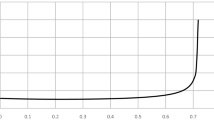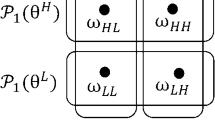Abstract
This paper studies rent-seeking contests where the contestants do not know the number of actively competing contestants. Two models are compared. In the first, all players are risk neutral; in the second, all have constant absolute risk aversion. If the expected fraction of active contestants is low, an increase in the number of potential contestants increases individual rent-seeking efforts. This effect is in contrast to the complete information case where individual rent-seeking efforts decrease in the number of contestants. The effect is more likely under risk neutrality, but also possible under risk aversion. Equilibrium rent seeking efforts are lower under risk aversion if and only if the expected fraction of active contestants is low.
Similar content being viewed by others
References
Baye, M.R., & Hoppe, H.C. (2003). The strategic equivalence of rent-seeking, innovation, and patent race games. Games and Economic Behavior, 44, 217–226.
Che, Y.-K., & Gale, I.L. (1997). Rent dissipation when rent seekers are budget constrained. Public Choice, 92, 109–126.
Che, Y.-K., & Gale, I.L. (1998). Caps on political lobbying. The American Economic Review, 88, 643–651.
Clark, D.J. (1997). Learning the structure of a simple rent-seeking game. Public Choice, 93 119–130.
Cornes, R., & Hartley, R. (2003). Risk aversion, heterogeneity and contests. Public Choice, 117 1–25.
Harstad, R.M., Kagel, J.H. & Levin, D. (1990). Equilibrium bid functions for auctions with an uncertain number of bidders. Economic Letters, 33 35–40.
Hillman, A.L., & Katz, E. (1984). Risk-Averse Rent Seekers and the Social Cost of Monopoly Power. The Economic Journal, 94 104–110.
Hurley, T.M., & Shogren J.F. (1998a). Effort levels in Cournot Nash Contest with asymmetric information. Journal of Public Economics, 69 195–210.
Hurley, T.M., & Shogren J.F. (1998b). Asymmetric information contests. European Journal of Political Economy 14 645–665.
Jansen, J. (2004). Innovating Under the Radar: Investment Dynamics under Asymmetric Information. Mimeo.
Janssen, M., & Rasmusen, E. (2002). Bertrand competition under uncertainty. The Journal of Industrial Economics 50(1), 11–21.s.
Konrad, K.A., & Schlesinger, H. (1997). Risk aversion in rent-seeking and rent-augmenting games. The Economic Journal, 107 1671–1683.
Lagerlöf, J. (2005). A Simple Theory of Rent Seeking with Informational Foundations. Mimeo.
Lockard, A., & Tullock, G. (eds.) (2000). Efficient rent-seeking: chronicle of an intellectual quagmire. Boston: Kluwer.
Malueg, D.A., & Yates, A.J. (2004). Rent Seeking With Private Values. Public Choice, 119 161–178.
McAfee, R.P., & McMillan, J. (1987), Auctions with a stochastic number of bidders. Journal of Economic Theory, 43 1–19.
Myerson, R.B., & Wärneryd, K. (2006). Population uncertainty in contests. Economic Theory, 27(2).
Nitzan, S. (1994). Modelling rent-seeking contests. European Journal of Political Economy, 10 41–60.
Skaperdas, S. (1991). Conflict and attitudes toward risk. American Economic Review Papers and Proceedings, 81 116–120.
Skaperdas, S. & Gan, L. (1995). Risk aversion in contests. The Economic Journal 105 951–962.
Skaperdas, S. (1996). Contest success functions. Economic Theory 7 283–290.
Tullock, G. (1980). Efficient rent seeking. In: Buchanan, J., Tollison, R., Tulock, G. (eds.), Towards a theory of the rent seeking society. College Station: Texas A&M University Press, pp. 97–112.
Wärneryd, K. (2003). Information in conflicts. Journal of Economic Theory, 110 121–136.
Author information
Authors and Affiliations
Corresponding author
Additional information
I want to thank an anonymous referee for suggesting to study risk aversion in the framework of the present paper. Any errors are mine. Financial support from the German Science Foundation through SFB/TR 15 is gratefully acknowledged.
JEL codes: D72, D82
Rights and permissions
About this article
Cite this article
Münster, J. Contests with an unknown number of contestants. Public Choice 129, 353–368 (2006). https://doi.org/10.1007/s11127-006-9035-y
Received:
Accepted:
Published:
Issue Date:
DOI: https://doi.org/10.1007/s11127-006-9035-y




